Nursing Assignment: Leadership's Role in Patient Safety
VerifiedAdded on 2022/12/18
|10
|2217
|43
Essay
AI Summary
This nursing assignment critically examines the crucial role of leadership in promoting patient safety within clinical settings. It begins by defining leadership and patient safety, establishing their interconnectedness, and then analyzes the impact of clinical leadership and Laissez faire leadership styles. The essay delves into the application of these leadership styles in the context of patient safety, highlighting the importance of clinical leadership in reducing medication errors, inpatient fall rates, and hospital-acquired infections. The assignment emphasizes that effective clinical leaders empower healthcare workers, foster a culture of safety, and implement evidence-based practices to enhance patient outcomes. It stresses the need for constant surveillance and the drawbacks of Laissez faire leadership, particularly in high-pressure clinical environments. The essay concludes by underscoring the significance of clinical leaders in preventing errors, promoting a shared vision, and achieving optimal patient care.
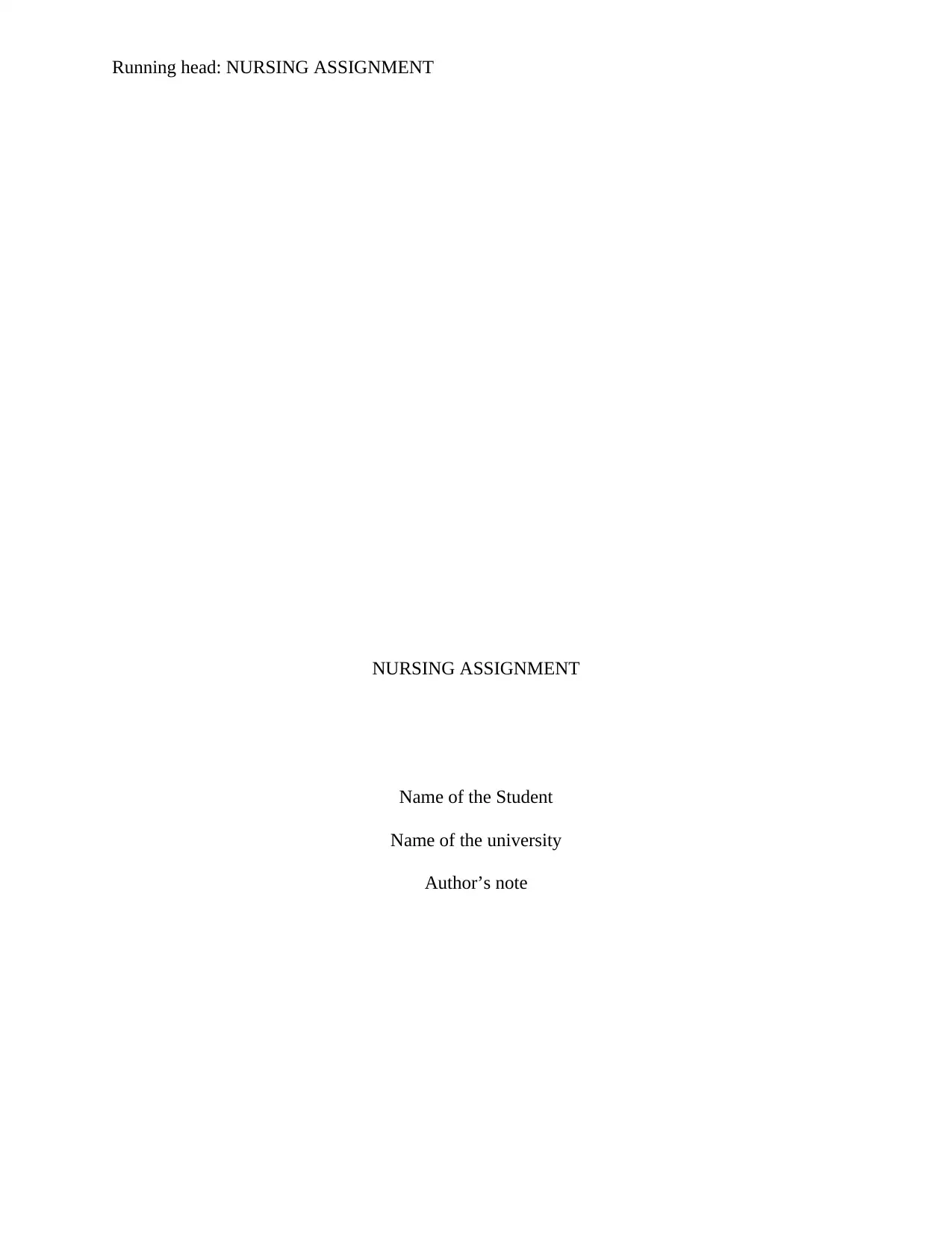
Running head: NURSING ASSIGNMENT
NURSING ASSIGNMENT
Name of the Student
Name of the university
Author’s note
NURSING ASSIGNMENT
Name of the Student
Name of the university
Author’s note
Paraphrase This Document
Need a fresh take? Get an instant paraphrase of this document with our AI Paraphraser

6
CRITIQUE OF THE ARTICLE
NURSING ASSIGNMENT
CRITIQUE OF THE ARTICLE
NURSING ASSIGNMENT
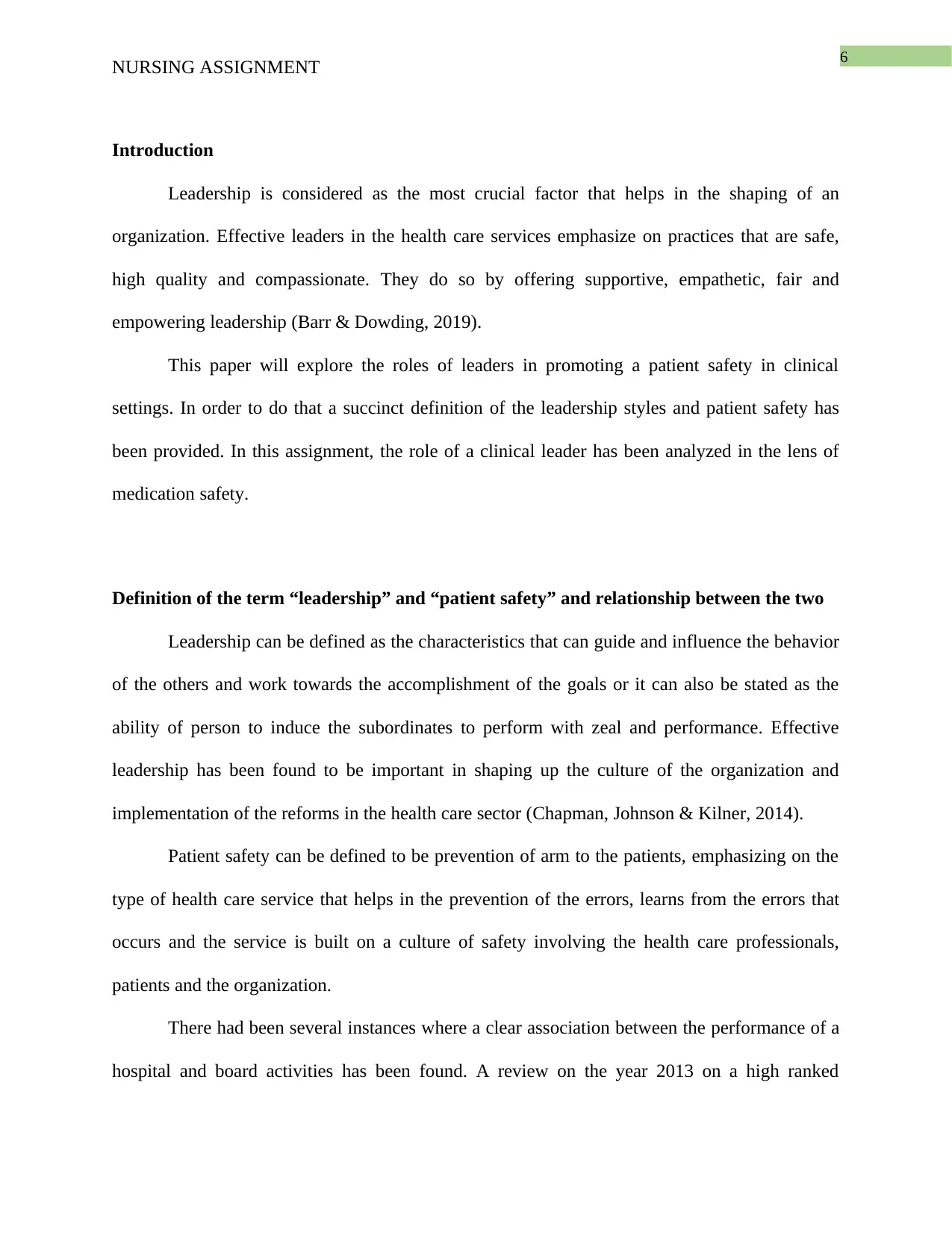
6
CRITIQUE OF THE ARTICLE
NURSING ASSIGNMENT
Introduction
Leadership is considered as the most crucial factor that helps in the shaping of an
organization. Effective leaders in the health care services emphasize on practices that are safe,
high quality and compassionate. They do so by offering supportive, empathetic, fair and
empowering leadership (Barr & Dowding, 2019).
This paper will explore the roles of leaders in promoting a patient safety in clinical
settings. In order to do that a succinct definition of the leadership styles and patient safety has
been provided. In this assignment, the role of a clinical leader has been analyzed in the lens of
medication safety.
Definition of the term “leadership” and “patient safety” and relationship between the two
Leadership can be defined as the characteristics that can guide and influence the behavior
of the others and work towards the accomplishment of the goals or it can also be stated as the
ability of person to induce the subordinates to perform with zeal and performance. Effective
leadership has been found to be important in shaping up the culture of the organization and
implementation of the reforms in the health care sector (Chapman, Johnson & Kilner, 2014).
Patient safety can be defined to be prevention of arm to the patients, emphasizing on the
type of health care service that helps in the prevention of the errors, learns from the errors that
occurs and the service is built on a culture of safety involving the health care professionals,
patients and the organization.
There had been several instances where a clear association between the performance of a
hospital and board activities has been found. A review on the year 2013 on a high ranked
CRITIQUE OF THE ARTICLE
NURSING ASSIGNMENT
Introduction
Leadership is considered as the most crucial factor that helps in the shaping of an
organization. Effective leaders in the health care services emphasize on practices that are safe,
high quality and compassionate. They do so by offering supportive, empathetic, fair and
empowering leadership (Barr & Dowding, 2019).
This paper will explore the roles of leaders in promoting a patient safety in clinical
settings. In order to do that a succinct definition of the leadership styles and patient safety has
been provided. In this assignment, the role of a clinical leader has been analyzed in the lens of
medication safety.
Definition of the term “leadership” and “patient safety” and relationship between the two
Leadership can be defined as the characteristics that can guide and influence the behavior
of the others and work towards the accomplishment of the goals or it can also be stated as the
ability of person to induce the subordinates to perform with zeal and performance. Effective
leadership has been found to be important in shaping up the culture of the organization and
implementation of the reforms in the health care sector (Chapman, Johnson & Kilner, 2014).
Patient safety can be defined to be prevention of arm to the patients, emphasizing on the
type of health care service that helps in the prevention of the errors, learns from the errors that
occurs and the service is built on a culture of safety involving the health care professionals,
patients and the organization.
There had been several instances where a clear association between the performance of a
hospital and board activities has been found. A review on the year 2013 on a high ranked
⊘ This is a preview!⊘
Do you want full access?
Subscribe today to unlock all pages.

Trusted by 1+ million students worldwide
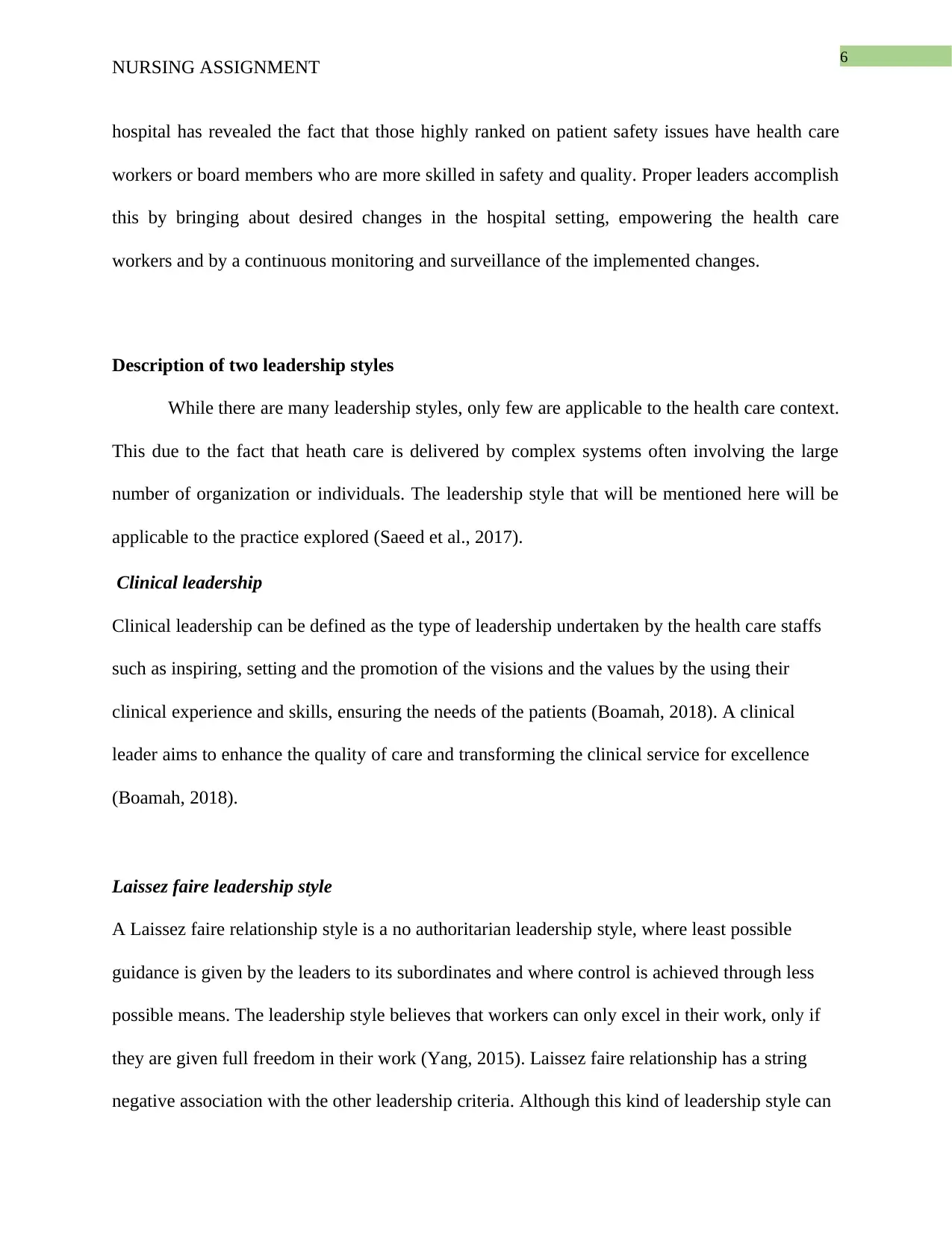
6
CRITIQUE OF THE ARTICLE
NURSING ASSIGNMENT
hospital has revealed the fact that those highly ranked on patient safety issues have health care
workers or board members who are more skilled in safety and quality. Proper leaders accomplish
this by bringing about desired changes in the hospital setting, empowering the health care
workers and by a continuous monitoring and surveillance of the implemented changes.
Description of two leadership styles
While there are many leadership styles, only few are applicable to the health care context.
This due to the fact that heath care is delivered by complex systems often involving the large
number of organization or individuals. The leadership style that will be mentioned here will be
applicable to the practice explored (Saeed et al., 2017).
Clinical leadership
Clinical leadership can be defined as the type of leadership undertaken by the health care staffs
such as inspiring, setting and the promotion of the visions and the values by the using their
clinical experience and skills, ensuring the needs of the patients (Boamah, 2018). A clinical
leader aims to enhance the quality of care and transforming the clinical service for excellence
(Boamah, 2018).
Laissez faire leadership style
A Laissez faire relationship style is a no authoritarian leadership style, where least possible
guidance is given by the leaders to its subordinates and where control is achieved through less
possible means. The leadership style believes that workers can only excel in their work, only if
they are given full freedom in their work (Yang, 2015). Laissez faire relationship has a string
negative association with the other leadership criteria. Although this kind of leadership style can
CRITIQUE OF THE ARTICLE
NURSING ASSIGNMENT
hospital has revealed the fact that those highly ranked on patient safety issues have health care
workers or board members who are more skilled in safety and quality. Proper leaders accomplish
this by bringing about desired changes in the hospital setting, empowering the health care
workers and by a continuous monitoring and surveillance of the implemented changes.
Description of two leadership styles
While there are many leadership styles, only few are applicable to the health care context.
This due to the fact that heath care is delivered by complex systems often involving the large
number of organization or individuals. The leadership style that will be mentioned here will be
applicable to the practice explored (Saeed et al., 2017).
Clinical leadership
Clinical leadership can be defined as the type of leadership undertaken by the health care staffs
such as inspiring, setting and the promotion of the visions and the values by the using their
clinical experience and skills, ensuring the needs of the patients (Boamah, 2018). A clinical
leader aims to enhance the quality of care and transforming the clinical service for excellence
(Boamah, 2018).
Laissez faire leadership style
A Laissez faire relationship style is a no authoritarian leadership style, where least possible
guidance is given by the leaders to its subordinates and where control is achieved through less
possible means. The leadership style believes that workers can only excel in their work, only if
they are given full freedom in their work (Yang, 2015). Laissez faire relationship has a string
negative association with the other leadership criteria. Although this kind of leadership style can
Paraphrase This Document
Need a fresh take? Get an instant paraphrase of this document with our AI Paraphraser
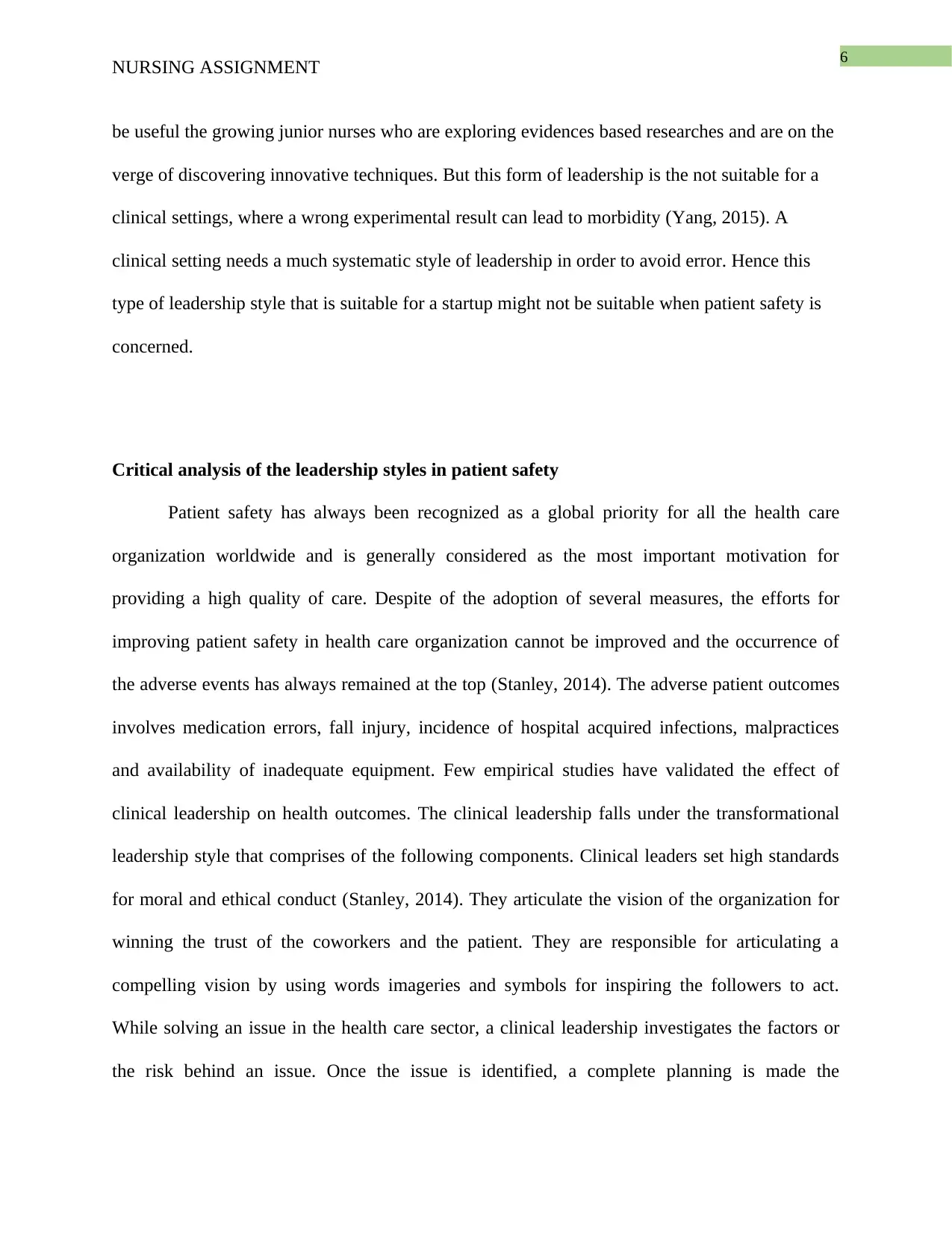
6
CRITIQUE OF THE ARTICLE
NURSING ASSIGNMENT
be useful the growing junior nurses who are exploring evidences based researches and are on the
verge of discovering innovative techniques. But this form of leadership is the not suitable for a
clinical settings, where a wrong experimental result can lead to morbidity (Yang, 2015). A
clinical setting needs a much systematic style of leadership in order to avoid error. Hence this
type of leadership style that is suitable for a startup might not be suitable when patient safety is
concerned.
Critical analysis of the leadership styles in patient safety
Patient safety has always been recognized as a global priority for all the health care
organization worldwide and is generally considered as the most important motivation for
providing a high quality of care. Despite of the adoption of several measures, the efforts for
improving patient safety in health care organization cannot be improved and the occurrence of
the adverse events has always remained at the top (Stanley, 2014). The adverse patient outcomes
involves medication errors, fall injury, incidence of hospital acquired infections, malpractices
and availability of inadequate equipment. Few empirical studies have validated the effect of
clinical leadership on health outcomes. The clinical leadership falls under the transformational
leadership style that comprises of the following components. Clinical leaders set high standards
for moral and ethical conduct (Stanley, 2014). They articulate the vision of the organization for
winning the trust of the coworkers and the patient. They are responsible for articulating a
compelling vision by using words imageries and symbols for inspiring the followers to act.
While solving an issue in the health care sector, a clinical leadership investigates the factors or
the risk behind an issue. Once the issue is identified, a complete planning is made the
CRITIQUE OF THE ARTICLE
NURSING ASSIGNMENT
be useful the growing junior nurses who are exploring evidences based researches and are on the
verge of discovering innovative techniques. But this form of leadership is the not suitable for a
clinical settings, where a wrong experimental result can lead to morbidity (Yang, 2015). A
clinical setting needs a much systematic style of leadership in order to avoid error. Hence this
type of leadership style that is suitable for a startup might not be suitable when patient safety is
concerned.
Critical analysis of the leadership styles in patient safety
Patient safety has always been recognized as a global priority for all the health care
organization worldwide and is generally considered as the most important motivation for
providing a high quality of care. Despite of the adoption of several measures, the efforts for
improving patient safety in health care organization cannot be improved and the occurrence of
the adverse events has always remained at the top (Stanley, 2014). The adverse patient outcomes
involves medication errors, fall injury, incidence of hospital acquired infections, malpractices
and availability of inadequate equipment. Few empirical studies have validated the effect of
clinical leadership on health outcomes. The clinical leadership falls under the transformational
leadership style that comprises of the following components. Clinical leaders set high standards
for moral and ethical conduct (Stanley, 2014). They articulate the vision of the organization for
winning the trust of the coworkers and the patient. They are responsible for articulating a
compelling vision by using words imageries and symbols for inspiring the followers to act.
While solving an issue in the health care sector, a clinical leadership investigates the factors or
the risk behind an issue. Once the issue is identified, a complete planning is made the
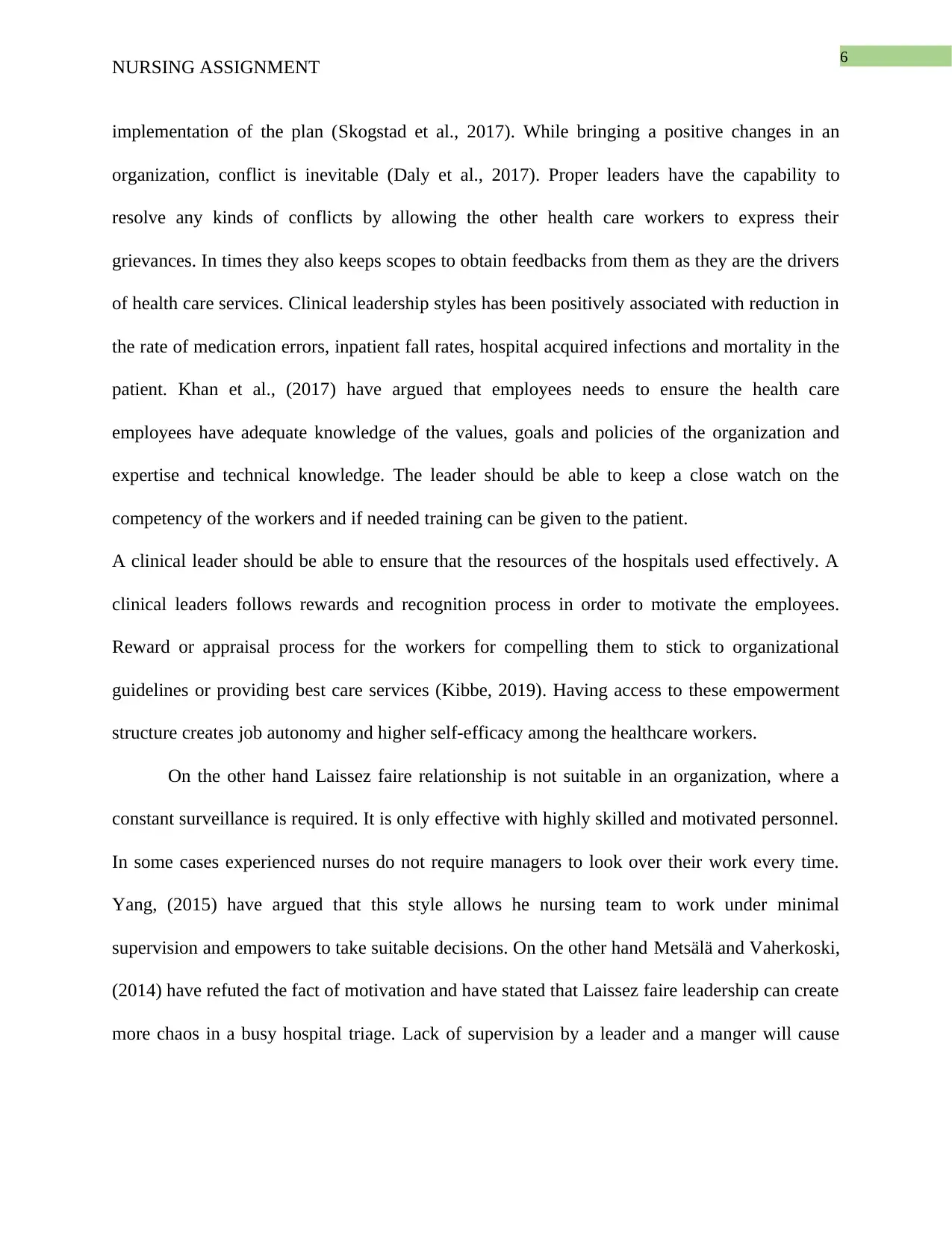
6
CRITIQUE OF THE ARTICLE
NURSING ASSIGNMENT
implementation of the plan (Skogstad et al., 2017). While bringing a positive changes in an
organization, conflict is inevitable (Daly et al., 2017). Proper leaders have the capability to
resolve any kinds of conflicts by allowing the other health care workers to express their
grievances. In times they also keeps scopes to obtain feedbacks from them as they are the drivers
of health care services. Clinical leadership styles has been positively associated with reduction in
the rate of medication errors, inpatient fall rates, hospital acquired infections and mortality in the
patient. Khan et al., (2017) have argued that employees needs to ensure the health care
employees have adequate knowledge of the values, goals and policies of the organization and
expertise and technical knowledge. The leader should be able to keep a close watch on the
competency of the workers and if needed training can be given to the patient.
A clinical leader should be able to ensure that the resources of the hospitals used effectively. A
clinical leaders follows rewards and recognition process in order to motivate the employees.
Reward or appraisal process for the workers for compelling them to stick to organizational
guidelines or providing best care services (Kibbe, 2019). Having access to these empowerment
structure creates job autonomy and higher self-efficacy among the healthcare workers.
On the other hand Laissez faire relationship is not suitable in an organization, where a
constant surveillance is required. It is only effective with highly skilled and motivated personnel.
In some cases experienced nurses do not require managers to look over their work every time.
Yang, (2015) have argued that this style allows he nursing team to work under minimal
supervision and empowers to take suitable decisions. On the other hand Metsälä and Vaherkoski,
(2014) have refuted the fact of motivation and have stated that Laissez faire leadership can create
more chaos in a busy hospital triage. Lack of supervision by a leader and a manger will cause
CRITIQUE OF THE ARTICLE
NURSING ASSIGNMENT
implementation of the plan (Skogstad et al., 2017). While bringing a positive changes in an
organization, conflict is inevitable (Daly et al., 2017). Proper leaders have the capability to
resolve any kinds of conflicts by allowing the other health care workers to express their
grievances. In times they also keeps scopes to obtain feedbacks from them as they are the drivers
of health care services. Clinical leadership styles has been positively associated with reduction in
the rate of medication errors, inpatient fall rates, hospital acquired infections and mortality in the
patient. Khan et al., (2017) have argued that employees needs to ensure the health care
employees have adequate knowledge of the values, goals and policies of the organization and
expertise and technical knowledge. The leader should be able to keep a close watch on the
competency of the workers and if needed training can be given to the patient.
A clinical leader should be able to ensure that the resources of the hospitals used effectively. A
clinical leaders follows rewards and recognition process in order to motivate the employees.
Reward or appraisal process for the workers for compelling them to stick to organizational
guidelines or providing best care services (Kibbe, 2019). Having access to these empowerment
structure creates job autonomy and higher self-efficacy among the healthcare workers.
On the other hand Laissez faire relationship is not suitable in an organization, where a
constant surveillance is required. It is only effective with highly skilled and motivated personnel.
In some cases experienced nurses do not require managers to look over their work every time.
Yang, (2015) have argued that this style allows he nursing team to work under minimal
supervision and empowers to take suitable decisions. On the other hand Metsälä and Vaherkoski,
(2014) have refuted the fact of motivation and have stated that Laissez faire leadership can create
more chaos in a busy hospital triage. Lack of supervision by a leader and a manger will cause
⊘ This is a preview!⊘
Do you want full access?
Subscribe today to unlock all pages.

Trusted by 1+ million students worldwide
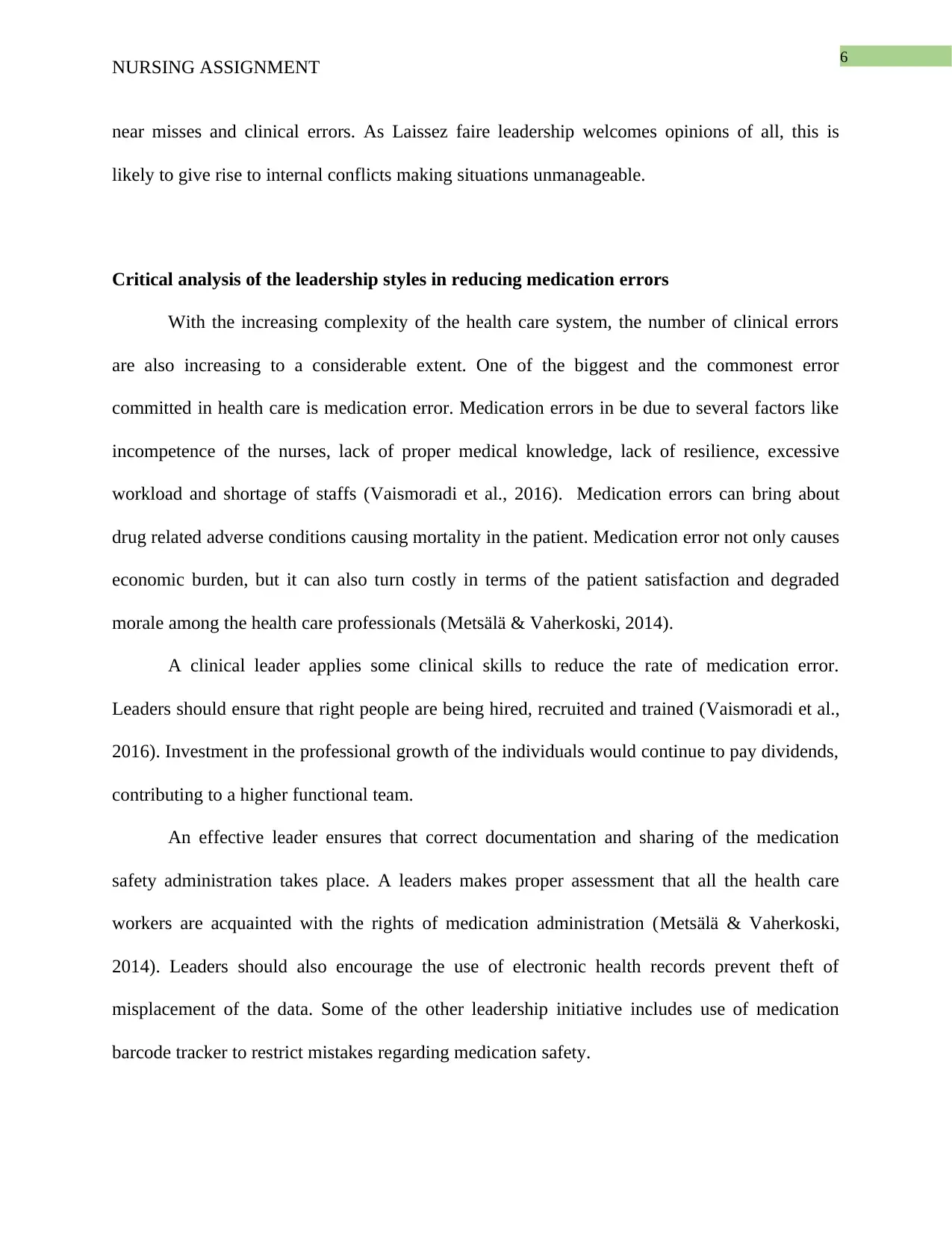
6
CRITIQUE OF THE ARTICLE
NURSING ASSIGNMENT
near misses and clinical errors. As Laissez faire leadership welcomes opinions of all, this is
likely to give rise to internal conflicts making situations unmanageable.
Critical analysis of the leadership styles in reducing medication errors
With the increasing complexity of the health care system, the number of clinical errors
are also increasing to a considerable extent. One of the biggest and the commonest error
committed in health care is medication error. Medication errors in be due to several factors like
incompetence of the nurses, lack of proper medical knowledge, lack of resilience, excessive
workload and shortage of staffs (Vaismoradi et al., 2016). Medication errors can bring about
drug related adverse conditions causing mortality in the patient. Medication error not only causes
economic burden, but it can also turn costly in terms of the patient satisfaction and degraded
morale among the health care professionals (Metsälä & Vaherkoski, 2014).
A clinical leader applies some clinical skills to reduce the rate of medication error.
Leaders should ensure that right people are being hired, recruited and trained (Vaismoradi et al.,
2016). Investment in the professional growth of the individuals would continue to pay dividends,
contributing to a higher functional team.
An effective leader ensures that correct documentation and sharing of the medication
safety administration takes place. A leaders makes proper assessment that all the health care
workers are acquainted with the rights of medication administration (Metsälä & Vaherkoski,
2014). Leaders should also encourage the use of electronic health records prevent theft of
misplacement of the data. Some of the other leadership initiative includes use of medication
barcode tracker to restrict mistakes regarding medication safety.
CRITIQUE OF THE ARTICLE
NURSING ASSIGNMENT
near misses and clinical errors. As Laissez faire leadership welcomes opinions of all, this is
likely to give rise to internal conflicts making situations unmanageable.
Critical analysis of the leadership styles in reducing medication errors
With the increasing complexity of the health care system, the number of clinical errors
are also increasing to a considerable extent. One of the biggest and the commonest error
committed in health care is medication error. Medication errors in be due to several factors like
incompetence of the nurses, lack of proper medical knowledge, lack of resilience, excessive
workload and shortage of staffs (Vaismoradi et al., 2016). Medication errors can bring about
drug related adverse conditions causing mortality in the patient. Medication error not only causes
economic burden, but it can also turn costly in terms of the patient satisfaction and degraded
morale among the health care professionals (Metsälä & Vaherkoski, 2014).
A clinical leader applies some clinical skills to reduce the rate of medication error.
Leaders should ensure that right people are being hired, recruited and trained (Vaismoradi et al.,
2016). Investment in the professional growth of the individuals would continue to pay dividends,
contributing to a higher functional team.
An effective leader ensures that correct documentation and sharing of the medication
safety administration takes place. A leaders makes proper assessment that all the health care
workers are acquainted with the rights of medication administration (Metsälä & Vaherkoski,
2014). Leaders should also encourage the use of electronic health records prevent theft of
misplacement of the data. Some of the other leadership initiative includes use of medication
barcode tracker to restrict mistakes regarding medication safety.
Paraphrase This Document
Need a fresh take? Get an instant paraphrase of this document with our AI Paraphraser
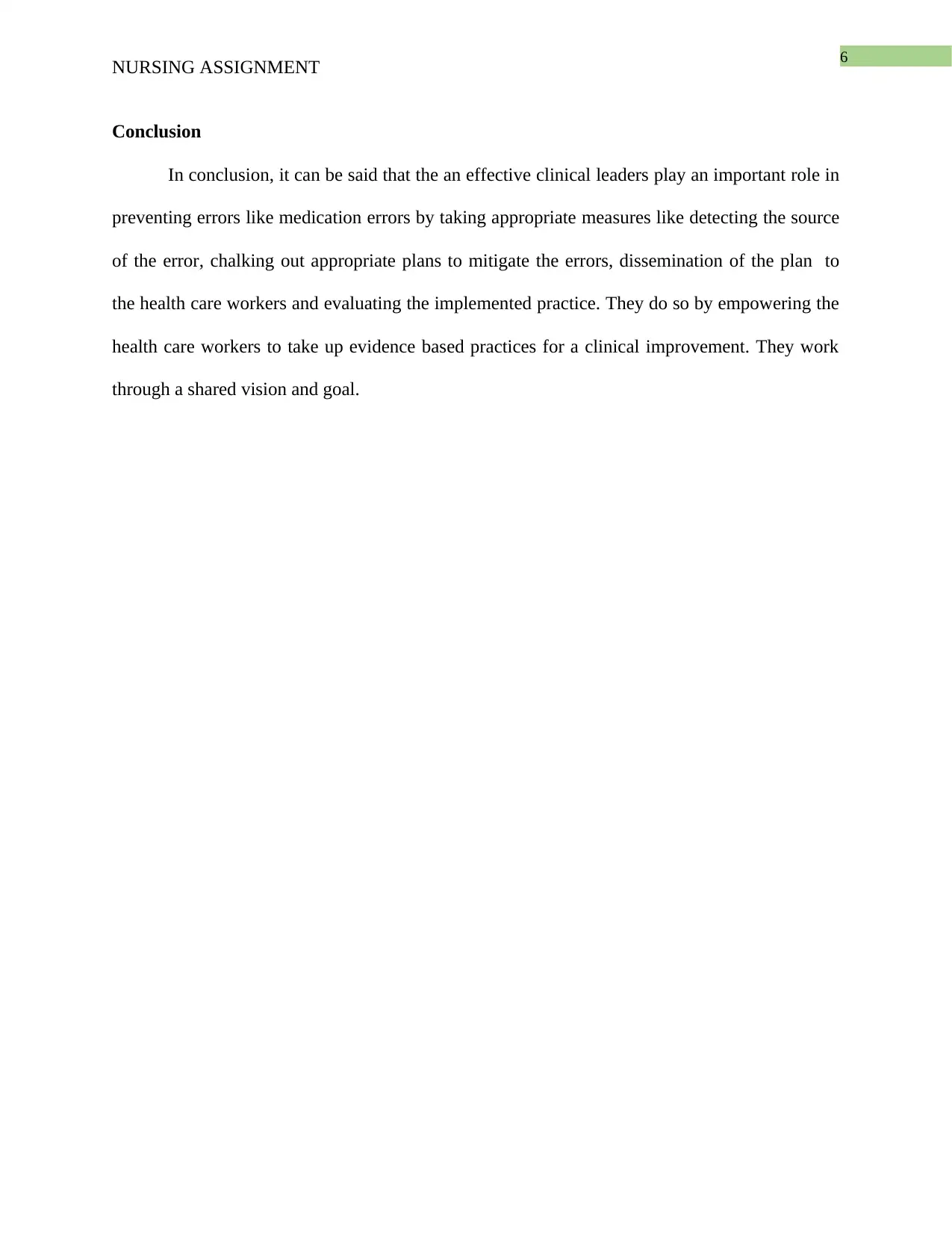
6
CRITIQUE OF THE ARTICLE
NURSING ASSIGNMENT
Conclusion
In conclusion, it can be said that the an effective clinical leaders play an important role in
preventing errors like medication errors by taking appropriate measures like detecting the source
of the error, chalking out appropriate plans to mitigate the errors, dissemination of the plan to
the health care workers and evaluating the implemented practice. They do so by empowering the
health care workers to take up evidence based practices for a clinical improvement. They work
through a shared vision and goal.
CRITIQUE OF THE ARTICLE
NURSING ASSIGNMENT
Conclusion
In conclusion, it can be said that the an effective clinical leaders play an important role in
preventing errors like medication errors by taking appropriate measures like detecting the source
of the error, chalking out appropriate plans to mitigate the errors, dissemination of the plan to
the health care workers and evaluating the implemented practice. They do so by empowering the
health care workers to take up evidence based practices for a clinical improvement. They work
through a shared vision and goal.
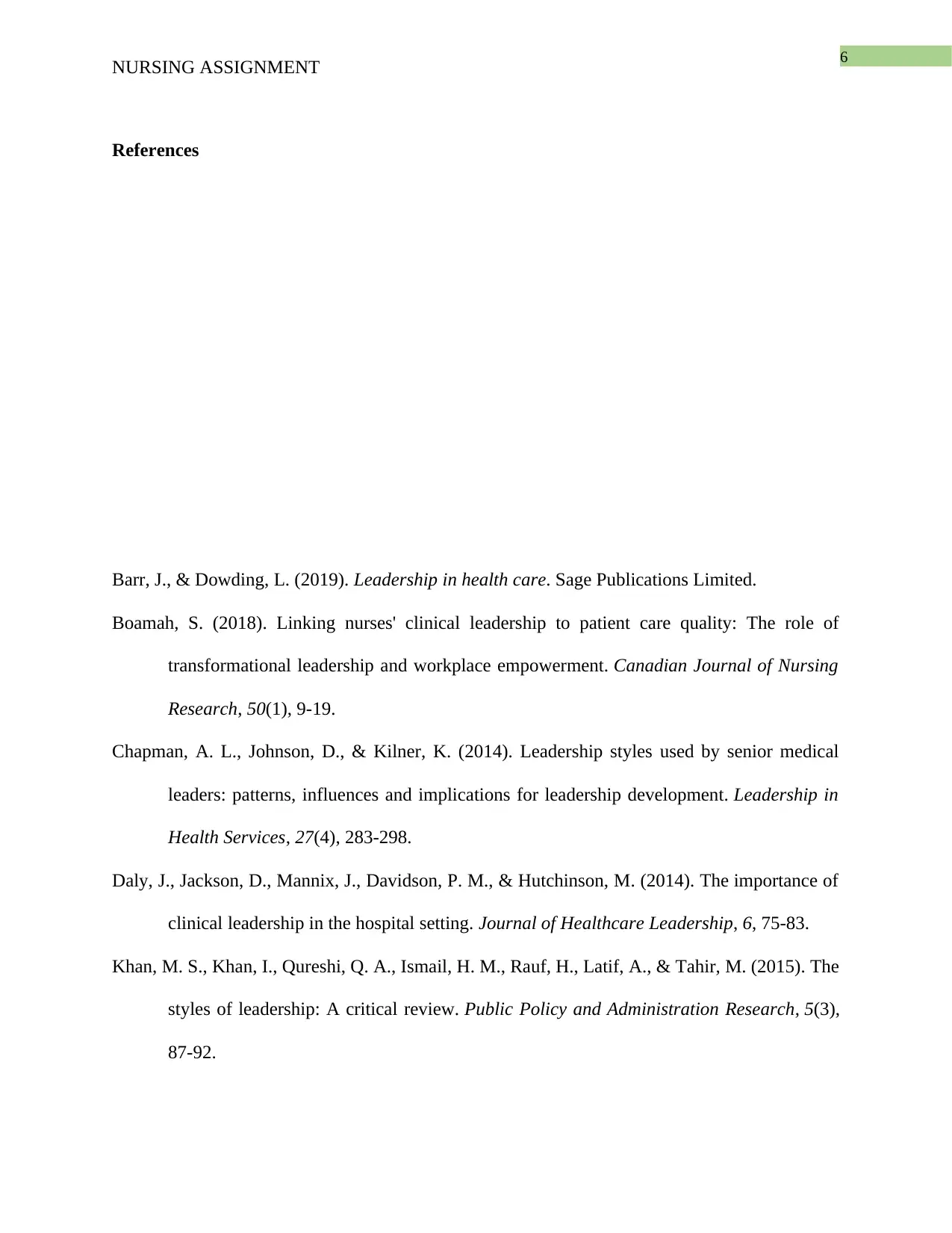
6
CRITIQUE OF THE ARTICLE
NURSING ASSIGNMENT
References
Barr, J., & Dowding, L. (2019). Leadership in health care. Sage Publications Limited.
Boamah, S. (2018). Linking nurses' clinical leadership to patient care quality: The role of
transformational leadership and workplace empowerment. Canadian Journal of Nursing
Research, 50(1), 9-19.
Chapman, A. L., Johnson, D., & Kilner, K. (2014). Leadership styles used by senior medical
leaders: patterns, influences and implications for leadership development. Leadership in
Health Services, 27(4), 283-298.
Daly, J., Jackson, D., Mannix, J., Davidson, P. M., & Hutchinson, M. (2014). The importance of
clinical leadership in the hospital setting. Journal of Healthcare Leadership, 6, 75-83.
Khan, M. S., Khan, I., Qureshi, Q. A., Ismail, H. M., Rauf, H., Latif, A., & Tahir, M. (2015). The
styles of leadership: A critical review. Public Policy and Administration Research, 5(3),
87-92.
CRITIQUE OF THE ARTICLE
NURSING ASSIGNMENT
References
Barr, J., & Dowding, L. (2019). Leadership in health care. Sage Publications Limited.
Boamah, S. (2018). Linking nurses' clinical leadership to patient care quality: The role of
transformational leadership and workplace empowerment. Canadian Journal of Nursing
Research, 50(1), 9-19.
Chapman, A. L., Johnson, D., & Kilner, K. (2014). Leadership styles used by senior medical
leaders: patterns, influences and implications for leadership development. Leadership in
Health Services, 27(4), 283-298.
Daly, J., Jackson, D., Mannix, J., Davidson, P. M., & Hutchinson, M. (2014). The importance of
clinical leadership in the hospital setting. Journal of Healthcare Leadership, 6, 75-83.
Khan, M. S., Khan, I., Qureshi, Q. A., Ismail, H. M., Rauf, H., Latif, A., & Tahir, M. (2015). The
styles of leadership: A critical review. Public Policy and Administration Research, 5(3),
87-92.
⊘ This is a preview!⊘
Do you want full access?
Subscribe today to unlock all pages.

Trusted by 1+ million students worldwide
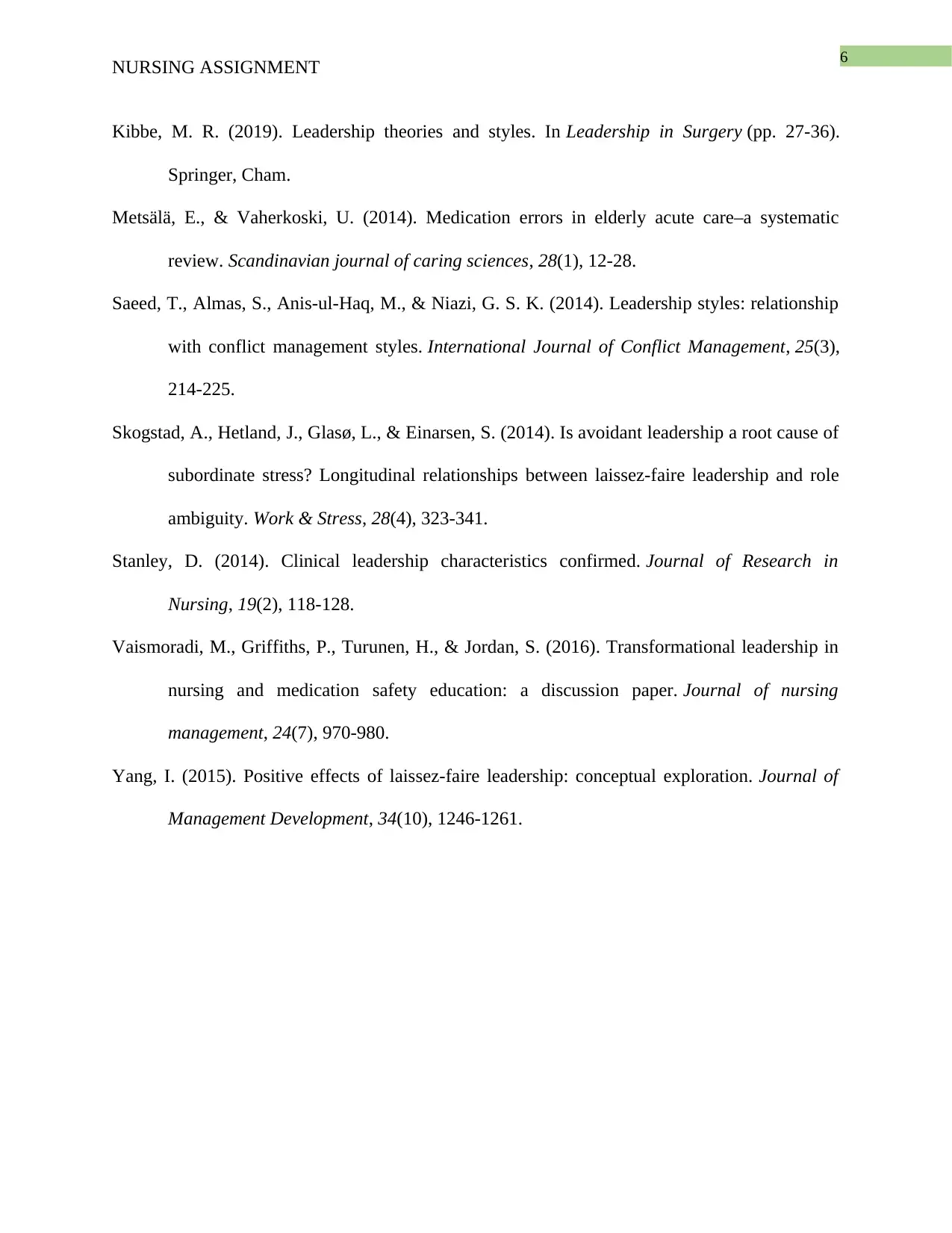
6
CRITIQUE OF THE ARTICLE
NURSING ASSIGNMENT
Kibbe, M. R. (2019). Leadership theories and styles. In Leadership in Surgery (pp. 27-36).
Springer, Cham.
Metsälä, E., & Vaherkoski, U. (2014). Medication errors in elderly acute care–a systematic
review. Scandinavian journal of caring sciences, 28(1), 12-28.
Saeed, T., Almas, S., Anis-ul-Haq, M., & Niazi, G. S. K. (2014). Leadership styles: relationship
with conflict management styles. International Journal of Conflict Management, 25(3),
214-225.
Skogstad, A., Hetland, J., Glasø, L., & Einarsen, S. (2014). Is avoidant leadership a root cause of
subordinate stress? Longitudinal relationships between laissez-faire leadership and role
ambiguity. Work & Stress, 28(4), 323-341.
Stanley, D. (2014). Clinical leadership characteristics confirmed. Journal of Research in
Nursing, 19(2), 118-128.
Vaismoradi, M., Griffiths, P., Turunen, H., & Jordan, S. (2016). Transformational leadership in
nursing and medication safety education: a discussion paper. Journal of nursing
management, 24(7), 970-980.
Yang, I. (2015). Positive effects of laissez-faire leadership: conceptual exploration. Journal of
Management Development, 34(10), 1246-1261.
CRITIQUE OF THE ARTICLE
NURSING ASSIGNMENT
Kibbe, M. R. (2019). Leadership theories and styles. In Leadership in Surgery (pp. 27-36).
Springer, Cham.
Metsälä, E., & Vaherkoski, U. (2014). Medication errors in elderly acute care–a systematic
review. Scandinavian journal of caring sciences, 28(1), 12-28.
Saeed, T., Almas, S., Anis-ul-Haq, M., & Niazi, G. S. K. (2014). Leadership styles: relationship
with conflict management styles. International Journal of Conflict Management, 25(3),
214-225.
Skogstad, A., Hetland, J., Glasø, L., & Einarsen, S. (2014). Is avoidant leadership a root cause of
subordinate stress? Longitudinal relationships between laissez-faire leadership and role
ambiguity. Work & Stress, 28(4), 323-341.
Stanley, D. (2014). Clinical leadership characteristics confirmed. Journal of Research in
Nursing, 19(2), 118-128.
Vaismoradi, M., Griffiths, P., Turunen, H., & Jordan, S. (2016). Transformational leadership in
nursing and medication safety education: a discussion paper. Journal of nursing
management, 24(7), 970-980.
Yang, I. (2015). Positive effects of laissez-faire leadership: conceptual exploration. Journal of
Management Development, 34(10), 1246-1261.
1 out of 10
Related Documents
Your All-in-One AI-Powered Toolkit for Academic Success.
+13062052269
info@desklib.com
Available 24*7 on WhatsApp / Email
![[object Object]](/_next/static/media/star-bottom.7253800d.svg)
Unlock your academic potential
Copyright © 2020–2025 A2Z Services. All Rights Reserved. Developed and managed by ZUCOL.





